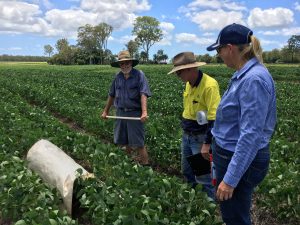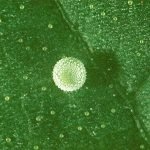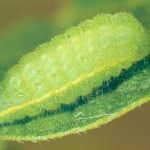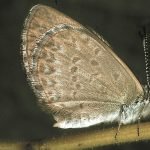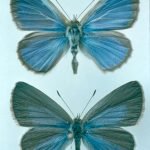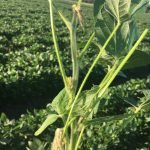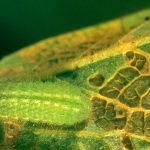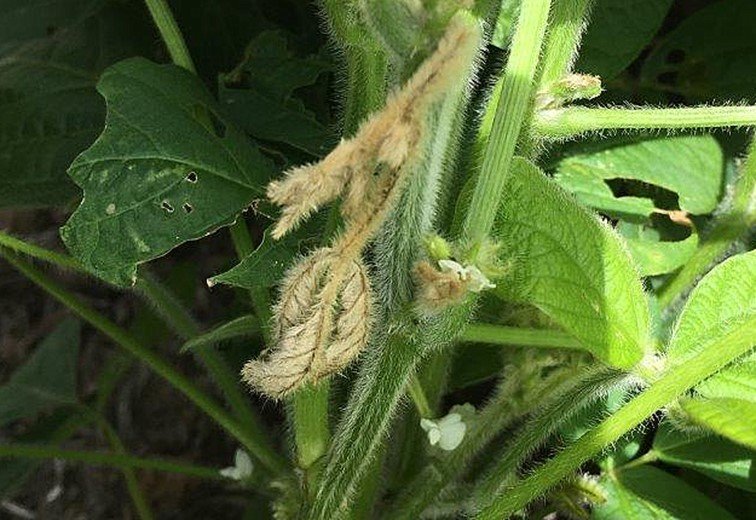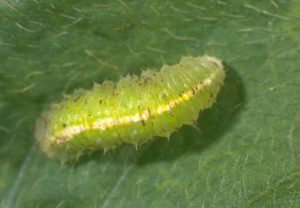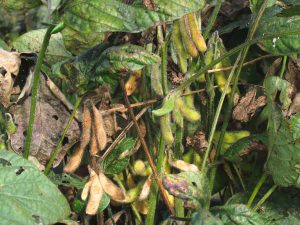A major outbreak of grass blue butterfly (GBB) (Zizina labradus) in late vegetative and flowering soybeans has been reported in the Maryborough/Hervey Bay region. Some crops inspected had 10-12 GBB larvae per square metre with many plants denuded of buds and flowers. Other crops had less damage and fewer larvae (4-5 per square metre), but had 5 or more adult butterflies per square metre. In these crops, the adult egg laying will potentially result in very high subsequent GBB larval populations. Entomologist Hugh Brier said this is by far the worst GBB outbreak he had ever seen in his 40+ year career.
UPDATE (30 January): There are reports of high numbers of GBB adults in some crops at Bundaberg. Growers are advised to keep watch, but not make any management decisions until larvae are found.
The green larvae are slug-like but have legs (visible when they are turned over) and are broader at the head end.
- GBB egg
- GBB larva
- GBB adult (side view)
- GBB adult (top view)
- GBB damage to soybean buds
- GBB damage to leaves
Some crops inspected also had worrying numbers of soybean aphids, with above-threshold populations (250 per plant) seen on many plants. Consequently, growers/consultants are urged to inspect their crops for both pests.
While GBB are not uncommon in coastal soybeans, most outbreaks normally start well before flowering and usually cause easily visible leaf and terminal damage. However in the infested flowering crops, damage was not immediately obvious when looking at the top of the canopy, but was detected when sampling. This was because beat sheet sampling dislodges not only the larvae, but also the damaged and dead buds and flowers.
While GBB larvae are quite small (reaching only 10 mm in length), it is their feeding behaviour that makes them so damaging—the larvae attack the base of bud and flower clusters. Consequently one ‘chew’ by a caterpillar can kill a cluster of buds and flowers which subsequently dry up and are easily dislodged. In some crops, sizable helicoverpa populations were also present, inflicting similar bud/flower damage, but also inflicting a lot more foliar damage.
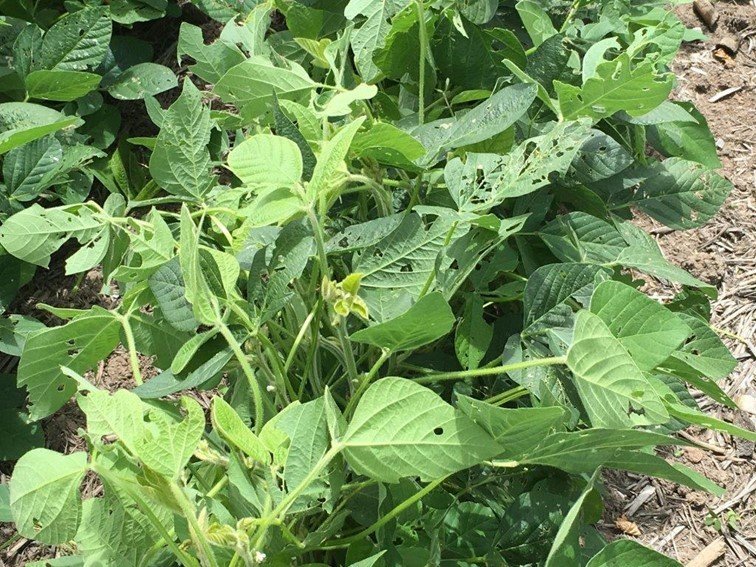
Crop with helicoverpa as well as grass blue damage, showing the very noticeable leaf chewing inflicted by the helicoverpa larvae
Note that as soybean flowers progress to the pod stage, the petals die and turn brown, but the surrounding bracts and buds stay green. In contrast where there is GBB damage, feeding damage at the base of the bud/flower cluster kills all structures, turning them brown.
For both caterpillar pests, the severe bud and flower damage may have been escalated by recent hot dry weather which stresses the plant’s leaves. This makes leaves less attractive to larvae, thereby reduces larval leaf feeding but leads to increased feeding on terminals, buds and flowers.
Many of the helicoverpa-infested crops were sprayed with Altacor (chlorantraniliprole) which is registered in soybeans against helicoverpa. Collections of both helicoverpa and GBB larvae post spray showed this pesticide was effective against both species. Accordingly an emergency use permit has been secured (PER 87644) for Altacor (or other registered products containing 350 g/kg chlorantraniliprole as their only active constituent), against GBB in soybeans at the helicoverpa-registered rate of 70 g/ha. This permit is valid from 23 January to 30 April 2019.
The reason Altacor is the permit product of choice is because it will give lengthy protection of crops against larvae hatching from eggs laid by GBB adults currently present in many crops at very high densities. Note that no other insecticides are currently registered in pulse crops against GBB, and that Altacor has minimal impact on beneficials preying on GBB and other soybean pests.
One key point to remember with Altacor is that larvae are not killed immediately. Rather they cease feeding and become increasingly moribund and shrunken before dying after 4-5 days. While the moribund state is relatively easy to detect in helicoverpa, it is less obvious in GBB larvae. If in doubt, collect larva and place in ventilated but escape-proof containers with freshly picked leaves from the sprayed crop. Larvae don’t move or feed much have been affected by the spray and will eventually die.
Note that Altacor is an ingestion product and requires a minimum spray volume of 100L of water/ha, but preferably 200L/ha in densely-canopies on narrow 50 cm rows as are common in coastal crops. When using Altacor, remember to add a non-ionic surfactant at 125 g a.i./100 L of water and adhere to other label guidelines.
The other pest of concern is the bright-green soybean aphid, which is at near or above-threshold levels in many crops. The US-based threshold is 250 aphids per plant, however as a rule of thumb, if you can see aphids on the main stem you are well over threshold. Many aphid-infested crops also have significant ladybird and hoverfly larvae populations, both of which are key aphid predators. The IPM aphid strategy is to watch crops closely during the vegetative and early flowering stages, to see if the predators are bringing the aphids under control. Critical to this strategy’s success is to only use soft insecticides during the vegetative stage to foster these and other beneficials.
Another key point is not to confuse hoverfly larvae with GBB larvae. The two are similar in outline (both are slug-like), but the hoverfly taper towards the head whereas the GBB larvae have a broad rounded head end. Hoverfly larvae also lack legs. A final ID clincher is to place the suspect on your hand. The good guy (hoverfly) will break into aphid hunting behaviour, raising their head and moving it up and down and from side to side. See a video of this behaviour or watch hoverfly larvae eat onion aphids.
However if aphid populations are still increasing, action needs to be taken as above-threshold populations lead to very uneven plant and pod maturity making harvest extremely difficult, with green plants and pods present when the crop should be harvest-ready. The softest and preferred aphid option is pirimicarb (PER 85152 – valid till 31 July 2019).
Some crops may require a dual Altacor/pirimicarb spray. While they are compatible, the preferred mixing protocol is to dissolve the pirimicarb granules first and pour into the spray tank, and then dissolve the Altacor granules and add them last to the tank. Note that both are rainfast after 2-3 hours.
Take home message = check your crops now
The author would like to thank Tony McDermott (MSF sugar) and Yolande Kliese (Northern AgriServices) for contributing to this article.

